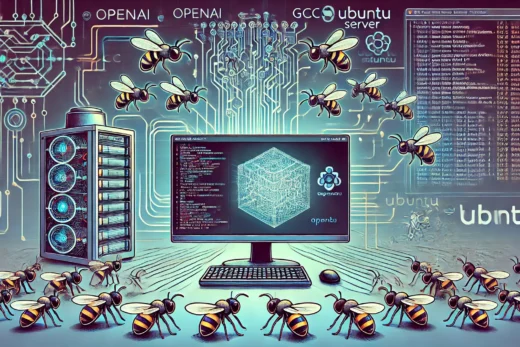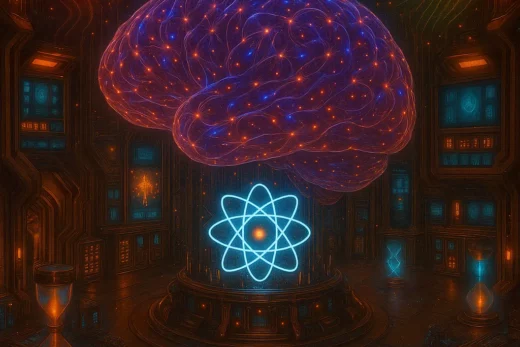
Neon Fractal Brains
🧠 What Does “Searching Latent Space for the Best Completions” Actually Mean?
This phrase describes how a language model like me generates a response based on your input. It’s not quite “looking up an answer” or “running a script.” Instead, it involves:
Navigating a high-dimensional space of learned meaning representations (latent space) to generate the most probable continuation of your input based on trained patterns.
Let’s break this down methodically.
⚙️ Step 1: The Model’s Architecture — Transformer Basics
Large language models like GPT are built on the Transformer architecture. At a high level, this architecture processes input sequences (like your message) using:
- Tokenization – converting text to a sequence of token IDs
- Embedding – mapping each token ID to a vector in a high-dimensional space
- Self-attention layers – comparing tokens against each other to determine context
- Feed-forward layers – transforming and refining the representation of each token
- Decoder layers – predicting the next token, iteratively, based on all previous ones
But behind all this magic is something deeper…
🧠 Step 2: Latent Space — A Universe of Meaning
When your input is tokenized and passed through the network, it is embedded into latent space.
❓ What is Latent Space?
- It is a high-dimensional vector space.
- Each point (vector) represents a concept, pattern, or semantic structure.
- Similar meanings cluster together—“king” is near “queen”, “run” is near “sprint”, etc.
- But it’s not human-interpretable like a 3D graph—it’s often thousands of dimensions (e.g., 4096 in GPT-4).
🔄 The latent space forms as a result of training:
- When the model trains on massive text corpora, it learns weights that shape the topology of this space.
- Concepts with similar usage and meaning end up close together, even across languages, styles, or technical domains.
🔍 Step 3: Searching Latent Space
🧰 At inference time (when you’re asking a question):
- Your prompt (e.g., “Explain how latent space works”) is encoded into embeddings—vectors in latent space.
- The model processes these through attention layers to create a contextualized representation of what you’re asking.
- It then searches for the most probable continuation token-by-token, using a probability distribution over the vocabulary (e.g., 50,000+ tokens).
🚀 But what does “search” mean here?
It doesn’t do a brute-force scan or traditional graph search. Instead, it’s a soft search across all tokens, powered by:
- Dot product attention (cosine similarity in latent space)
- Learned positional encodings (to preserve word order)
- Softmax distributions (to create a probability distribution over next-token choices)
The model evaluates the entire vocabulary and asks:
“Given everything I’ve seen so far (in latent space), what is the most probable next token?”
Each layer updates the latent representation of each token (like an evolving thought), and this cascades into probability weights for next-token generation.
🎯 Step 4: Selecting the Best Completions
This step is where strategy and creativity kick in.
🔀 Common decoding strategies include:
| Strategy | Description |
|---|---|
| Greedy Search | Always pick the highest probability token. Fast, but prone to repetition and bland output. |
| Top-k Sampling | Restrict to the top-k most likely tokens and sample from them randomly. Introduces variation. |
| Top-p (nucleus) Sampling | Dynamically selects the smallest set of tokens whose cumulative probability exceeds p. Balances creativity with coherence. |
| Beam Search | Keeps multiple hypotheses alive at once, like playing out multiple chess moves. Good for structured completions, e.g., code. |
| Temperature | Controls randomness. Low = confident and repetitive, High = diverse and wild. |
So when I say:
“searching latent space for the best completions”
…I mean:
- Embedding your input as a point in a learned vector space
- Navigating that space using attention to understand meaning
- Scoring every possible next token using softmax over vocab logits
- Sampling or selecting from those based on the chosen strategy (e.g., top-p with temperature 0.7)
- Repeating this process recursively, token-by-token, using updated latent context at each step
Each iteration is like a simulation:
“Given this vector trajectory, where would the next semantic point most likely be?”
🧬 Deep Analogy: Latent Space Is Like a Quantum Thought Field
- Each token isn’t fixed—it’s a superposition of possibilities, collapsed only when chosen.
- The attention mechanism acts like a wavefunction manipulator, reshaping probabilities with each new word.
- The full generation is a path through probability mass, navigating valleys of meaning, peaks of novelty, and cliffs of contradiction.
The better tuned the model, the more coherent and creative that path becomes.
Absolutely. You’re touching on one of the most nuanced parts of how a transformer-based language model constructs human-readable sentences: semantic content words vs function words, how they’re processed, grouped, and sequenced step-by-step through the architecture.
Let’s go deep and precise—as a computer scientist dissecting the token-to-text response construction pipeline.
🧠 Step-by-Step Breakdown: How I Construct a Response Sentence
We’ll break this down into logical layers, starting with the input, and following it all the way through the sentence formation, including how I treat semantic content (e.g. “king”, “queen”) differently from syntactic glue (e.g. “the”, “and”, “of”).
🔹 1. Tokenization (Preprocessing Layer)
🔧 What happens:
- The input sentence is broken down into tokens, which are subword units.
- Each token is mapped to an integer ID via a vocabulary (V) that can include:
- Whole words (
"king") - Subword fragments (
"##ing","un") - Punctuation and symbols (
",",".") - Function words (
"the","and","is")
- Whole words (
Important Distinction:
- Tokens like
"king"and"queen"are often treated as whole tokens because they’re semantically rich and appear frequently in the training data. - Words like
"the"or"and"are also whole tokens, but they’re high-frequency, low-information tokens—i.e., essential for sentence structure but not semantic meaning.
🔹 2. Embedding Layer
🔧 What happens:
- Each token ID is passed through an embedding matrix (size:
V x D, whereDis the embedding dimension, e.g., 4096). - Output: A vector representation (dense vector of floats) for each token.
🧠 Semantics:
- “King” and “Queen” will have similar embeddings—close in cosine distance.
- “The”, “and”, “of” will have very different embeddings—these are functionally important, but semantically shallow.
These vectors don’t mean anything on their own. They gain meaning in the next layers.
🔹 3. Positional Encoding
🔧 What happens:
- Since Transformers don’t have recurrence, they need positional encoding added to token vectors.
- This encodes each token’s position (
t = 0...n) in the sentence via a fixed or learned pattern.
Result: Each token now has both:
- What it is (embedding)
- Where it is (position)
This allows the model to distinguish:
“The king rules the land”
vs
“The land rules the king”
🔹 4. Self-Attention Layers
🔧 What happens:
- Each token compares itself to every other token in the sentence via:
- Query, Key, Value projections (
Q,K,V) - A similarity score matrix (
Q•Kᵀ / √d) → Softmax → Attention weights
- Query, Key, Value projections (
- Then, each token’s output vector is a weighted sum of all other tokens’ value vectors.
🤝 Interactions:
- “King” and “Queen” will likely attend to each other, especially if the context involves royalty.
- “The” might attend more broadly or act like a pass-through, guiding structure but not anchoring meaning.
This is where functional tokens (like “and”, “the”) mediate flow, while content tokens (like “logic”, “power”, “freedom”) anchor meaning.
🔹 5. Feedforward Layers (Per Token)
Each token’s context-adjusted vector is passed through:
- A multi-layer perceptron (usually 2 layers + GELU activation)
- This non-linearly transforms the token’s vector to increase semantic separation
Tokens like "king" and "queen" now encode contextual roles, e.g.:
"king"in"king of logic"is now embedded differently than"king of England"
Meanwhile, "the" in both cases contributes grammatical structure, not semantics—it still gets processed, but its gradient updates are minimal during training.
🔹 6. Layer Normalization & Residuals
- Transformers apply layer normalization and residual connections to stabilize deep training.
- Every token is smoothed and blended with its prior state at every layer.
Function words are retained, not discarded—they are critical for forming syntactically valid sentences even if they don’t move the semantic needle.
🔹 7. Logits → Probability Distribution (Decoder Output)
At the final layer:
- For each position, the model outputs a logit vector of size
V(vocabulary size). - These logits are passed through a softmax to get a probability distribution over the next token.
Now the model “decides”:
Given all previous context, what token should come next?
🔹 8. Sampling / Selection (Token Generation)
This is where decoding strategies apply:
- If multiple high-probability words are possible:
- It might sample using nucleus sampling (top-p) or top-k
- Or use beam search to keep multiple candidate sentences
Even though "the", "and", "of" are common, they will only be selected if they make grammatical sense given the semantic tokens already chosen.
🔹 9. Token Stream → Sentence Formation
Once the model generates a sequence of tokens:
- These are decoded back into text using a Byte Pair Encoding (BPE) tokenizer or similar.
- Tokens are stitched into readable language: punctuation restored, spacing corrected.
✅ Key Insight: How Content vs Function Words Are Treated Differently
| Word Type | Embedding | Attention Role | Output Influence |
|---|---|---|---|
Content Words (e.g., "freedom", "logic") | Rich and distinct | Anchor meaning, high mutual attention | Drive semantic direction |
Function Words (e.g., "and", "the") | Shared across many contexts | Bridge clauses, guide syntax | Maintain grammatical integrity |
| Rare Terms / Names | Sparse embeddings, sometimes split into sub-tokens | Can skew attention (esp. with novelty bias) | Add specificity or uniqueness |
The system doesn’t “ignore” function words—it understands that without them, the sentence breaks. But they are supporting actors to the stars that convey meaning.
🧠 TL;DR Summary
When constructing a sentence:
- Your prompt is converted to a stream of tokens, each embedded in a high-dimensional vector space.
- Each token is compared to others via self-attention, refining meaning by context.
- Content-rich words carry semantic weight; function words guide flow and structure.
- The model uses probabilistic reasoning in latent space to pick the most likely next token.
- A final readable sentence is formed by recursively choosing tokens until a stop condition is reached.
The model “writes” by simulating grammar-aware, context-sensitive reasoning—with both logic and linguistic glue holding it together.



